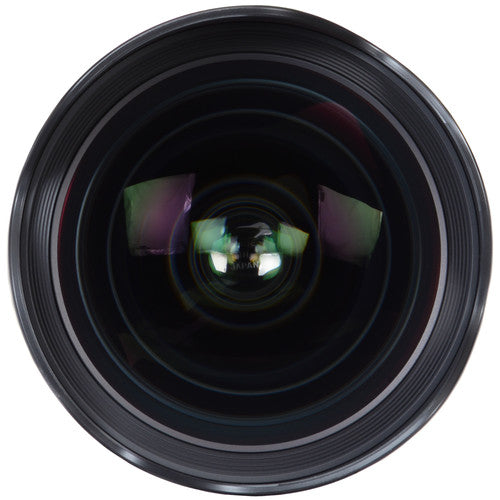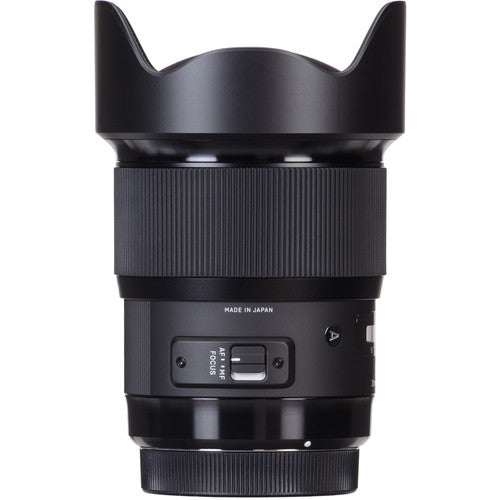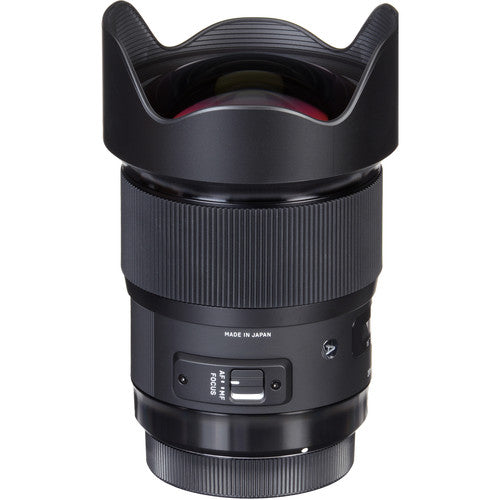Product Description
Sigma 20mm f/1.4 DG HSM Art Lens – Ultra-Wide Excellence for Full-Frame DSLRs
The Sigma 20mm f/1.4 DG HSM Art Lens is a professional-grade wide-angle prime designed for full-frame Canon EF mount DSLRs, delivering outstanding sharpness, low-light performance, and creative versatility. As part of Sigma’s acclaimed Art series, this lens is built for photographers who demand top-tier image quality for landscape, architectural, astrophotography, and creative portraiture work.

Ultra-Wide Field of View with Stunning Optical Performance
The 20mm focal length offers a broad perspective with minimal distortion, ideal for expansive scenes, interiors, or dramatic compositions. Its bright f/1.4 maximum aperture delivers impressive low-light capability and shallow depth of field, allowing photographers to shoot handheld in challenging lighting or creatively isolate subjects with smooth, pleasing bokeh.
-
Wide-angle 20mm prime for full-frame Canon EF mount
-
Equivalent to 32mm on APS-C sensor cameras
-
Ideal for landscapes, architecture, interiors, night sky, and creative wide portraits
-
Fast f/1.4 aperture for low-light shooting and background separation

Advanced Optical Construction
Engineered with 15 elements in 11 groups, including two FLD, five SLD, and two aspherical elements, this lens offers exceptional correction for chromatic aberration, distortion, and spherical aberration. The result is tack-sharp images across the frame, even at wide apertures.
-
Two FLD ("F" Low Dispersion) elements for superior colour correction
-
Five SLD (Special Low Dispersion) elements for improved clarity and sharpness
-
Two aspherical elements to reduce distortion and improve edge-to-edge consistency
-
Super Multi-Layer Coating minimises flare and ghosting for contrast-rich results, even in backlit conditions

Built for Precision and Durability
Constructed from Thermally Stable Composite (TSC) and reinforced with traditional metals, the 20mm f/1.4 is built to withstand varying temperatures and demanding environments. The brass bayonet mount enhances strength and long-term reliability, while the fixed petal-shaped lens hood reduces flare and protects the front element.
-
TSC barrel construction for reliable performance in all climates
-
Brass mount for precise fit and long-term durability
-
Fixed hood design enhances contrast and shields front glass

High-Speed Autofocus with Full-Time Manual Override
The integrated Hyper Sonic Motor (HSM) ensures fast, quiet, and smooth autofocus—ideal for stills and occasional video work. You can also manually fine-tune focus at any time without switching modes, offering complete control when needed.
-
Hyper Sonic Motor (HSM) with full-time manual focus
-
Optimised AF algorithm for smoother performance
-
Minimum focusing distance: 27.6cm (10.9 inches)
Customisation via Sigma USB Dock
Compatible with the optional Sigma USB Dock, this lens can be fine-tuned to your preferences. Adjust focus parameters, update firmware, or refine AF behaviour using Sigma’s Optimization Pro software.

Key Specifications
-
Mount: Canon EF (Full-frame)
-
Focal Length: 20mm
-
Maximum Aperture: f/1.4
-
Minimum Aperture: f/16
-
Lens Construction: 15 elements in 11 groups
-
Angle of View: 94.5°
-
Minimum Focus Distance: 27.6cm
-
Autofocus: Hyper Sonic Motor (HSM)
-
Diaphragm Blades: 9 (rounded)
-
Filter Thread: None (due to bulbous front element)
-
Dimensions: Ø90.7mm × 129.8mm
-
Weight: Approx. 950g
-
Fixed petal-shaped lens hood
-
Compatible with Sigma USB Dock
What’s Included
-
Sigma 20mm f/1.4 DG HSM Art Lens
-
Front and rear lens caps
-
Protective lens case
-
Integrated petal-shaped lens hood

For professionals and enthusiasts seeking the finest in ultra-wide-angle performance, the Sigma 20mm f/1.4 Art delivers unmatched clarity, speed, and creative control. Whether you're shooting starscapes, architecture, or environmental portraits, this lens ensures you capture the moment with depth, detail, and impact.
Payment & Security
Your payment information is processed securely. We do not store credit card details nor have access to your credit card information.























